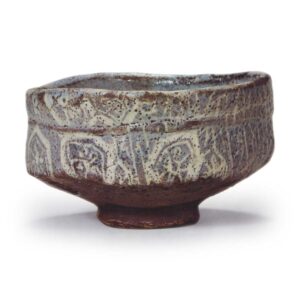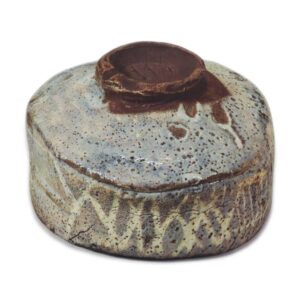

Collection: Nezu Museum
Height: 8.0 – 8.8 cm
Diameter: 14.0 cm
Foot diameter: 5.8 cm
Height of rim: 1.1 cm
The Yamahata tea bowl is one of the most famous of Shino wares, and is one of the famous bowls that immediately comes to mind when people think of Shino. The name of the tea bowl is taken from a poem in the Natsuka (Summer Song) section of the Tamaya Waka Shu (Anthology of Poems Composed by the Court Ladies) by the Emperor Go-Sei, which goes “The early-summer rain is about to clear, as the clouds on the edge of the mountain are growing thin” (translated from the original Japanese). is also thought to be the work of the Empress, but the author’s mental image is probably that of the pale white Shino glaze on the mouse-purple skin of this teacup, which is reminiscent of the thin clouds on the edge of a mountain where the early-summer rain is falling.
I would like to say that this is a truly appropriate name for this tea bowl, which is beautiful in its own right, but I think it is also a realistic representation of the characteristics of so-called mouse Shino, including the mountain edge.
Nezumi-shino is a type of Shino ware in which a white slip made from iron oxide is applied to white clay, and then a pattern is carved into it and the white slip is fired, and then a white feldspar glaze is applied. the way the white Shino glaze, or the dark or light tinge of it, shows through the Oniita makeup clay to reveal a dark purple color, is very much like the appearance of a dark purple mountain surface seen through thin white clouds just before it starts to rain, and this poem describes the atmosphere of Nezumi Shino in great detail.
The shape is generally shallow and flat, with a lot of scraping at the hem, and the foot is slightly high, with a sense of rising up. The waist is clearly wrapped in a mountain path, and the rim of the mouth is uneven in height, and the body is also heavily scraped , and the shape of the body also has a rugged and unregulated feel, overflowing with strength. The base, which is supported by the carelessly carved out body, is also sturdy, and does not waver by even a millimeter. It is truly a work that is both bold and vigorous, and yet also has a mysterious charm that is endless.
The entire surface is covered in a decorative clay coating, and on the exterior, a large tortoiseshell pattern reminiscent of the Hina and Momoyama Noh costumes is carved in white, and the interior is also carved in white with Hina and tortoiseshell patterns, with Shino glaze covering the entire piece, leaving only the foot ring. The glaze has a variety of different shades, and the color of the slip shines through it, giving it a beautiful purple hue. The glaze is covered in the characteristic holes of Koshi-no-yaki, and there are also glaze runs and finger marks on the side of the foot ring, which also add to the charm of the piece. The kiln mark of a diagonal cross is carved into the foot ring.
When you look at the bowl upside down, the waist is almost triangular, and in that respect it is similar to Asahagi, but the style of the two is different, and it is thought that the potters were different. In the case of molding with this kind of deformation, are there also common aspects that arise naturally, such as the way the waist is taken?
Yamahata tea bowl It is said that this tea bowl, along with Uka-bai, Asahagi, Hirosawa, Hagoromo, Sumiyoshi, and Mine-momiji, was created in the Momoyama period at the Oogaya and Koyagaya kilns, but its origins are unclear.
Bag White crepe
Inner box Paulownia wood, no signature on the lid, “Yamahata” written on the back of the lid “The clouds over the mountain ridge are getting thinner as the early-summer rain clears up”



